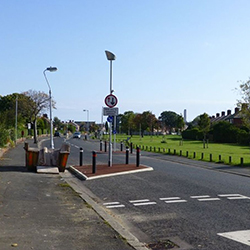Traffic calming devices are essential tools for enhancing the safety and livability of neighborhoods. They serve to slow down traffic, making streets safer for pedestrians, cyclists, and local residents. The primary goal is to reduce the negative impacts of motor vehicle use, alter driver behavior, and improve conditions for non-motorized street users.
By addressing these concerns, traffic calming measures contribute to creating a more inviting and community-oriented environment. The implementation of such devices must be carefully considered to ensure they meet the specific needs of the community they serve.
The Role of Traffic Calming in Modern Communities
Types of Traffic Calming Devices
Traffic calming devices are essential tools for enhancing road safety and reducing vehicle speeds in residential areas. The variety of devices available allows communities to tailor solutions to their specific needs.- Speed bumps: Short, raised areas of pavement typically used in parking lots or low-speed areas.
- Speed humps: Longer, more gradual raised areas designed for residential streets.
- Speed tables: Elevated sections of road with a flat top, often used at pedestrian crossings.
- Speed cushions: Similar to speed humps, but with gaps to allow emergency vehicles to pass without slowing down.
Speed Bumps vs. Speed Humps: Knowing the Difference
Speed bumps and speed humps are both traffic calming devices designed to slow down vehicles, but they serve different purposes and are suited to different environments. Speed bumps are abrupt and typically used in low-speed areas such as parking lots and driveways. They are shorter in length and have a greater height, causing a more pronounced slowing effect on vehicles. Speed humps, on the other hand, are more gradual and are often found on residential streets. They are longer in width and have a lower profile compared to speed bumps, allowing for a smoother transition for vehicles at moderate speeds. This makes them less disruptive for emergency vehicles and buses. When considering which device to implement, communities should evaluate the following factors:- The target speed for the area
- The volume and type of traffic
- The presence of pedestrian and bicycle traffic
- The impact on emergency response times
The Impact of Traffic Calming on Emergency Services
Balancing Safety with Emergency Response Times
In the quest to enhance neighborhood safety through traffic calming measures, it’s crucial to consider the potential impact on emergency response times. Speed humps and other devices can inadvertently delay first responders, such as firefighters and paramedics, during critical situations.- Speed humps and raised safety platforms can slow down emergency vehicles.
- Narrowing lanes may hinder the maneuverability of larger vehicles.
- In-lane bus stops could lead to congestion, further delaying response times.
Consulting with Emergency Services During Planning
Incorporating the perspective of emergency services is crucial when planning traffic calming measures. Consultations with fire, police, and ambulance services can reveal critical insights into how traffic calming devices might affect response times. These discussions should aim to find a balance between community safety and efficient emergency access. Key considerations include:- The type and placement of devices to ensure they do not impede emergency vehicles.
- The potential need for override systems, like removable bollards or gates, that allow emergency vehicles to bypass certain measures.
- Training for emergency personnel on navigating areas with traffic calming devices to minimize delays.
Adapting Designs to Accommodate Emergency Vehicles
When integrating traffic calming measures, it’s crucial to consider the needs of emergency vehicles. Design adaptations are essential to ensure that these critical services are not impeded. For instance, wider lanes or mountable curbs can allow for the swift passage of fire trucks and ambulances. Key considerations include:- The minimum required widths for emergency vehicles
- The placement of devices to allow for unobstructed emergency lanes
- The use of materials that can withstand the weight and frequency of emergency vehicles
Implementation and Community Outreach
Educating the Public on Traffic Calming Benefits
Public education is a critical component in the successful implementation of traffic calming measures. Community awareness and understanding of the benefits these devices provide can significantly enhance their effectiveness.- Traffic calming measures, such as speed bumps and roundabouts, are designed to reduce vehicle speeds and improve safety for pedestrians and cyclists.
- By informing residents about the positive impact on neighborhood safety and quality of life, support for these initiatives can be bolstered.
- Educational campaigns can also clarify the purpose of various devices, helping to minimize frustration and resistance from drivers.
The Process of Implementing Traffic Calming Devices
The implementation of traffic calming devices follows a structured process that begins with a comprehensive assessment of the community’s needs. This initial step is crucial to ensure that the measures taken are both effective and appropriate for the specific areas of concern.- Initiate a request: A formal request for traffic calming measures is typically required, often initiated by residents or a neighborhood association.
- Preliminary evaluation: Traffic engineers conduct a preliminary evaluation to determine if the request is warranted based on established criteria.
- Develop a plan: If the evaluation supports the need for traffic calming, a detailed plan is developed, outlining the proposed devices and their locations.
- Community engagement: The plan is then presented to the community for feedback, ensuring that residents have a say in the final decisions.
- Implementation: Once approved, the traffic calming devices are installed according to the plan.

